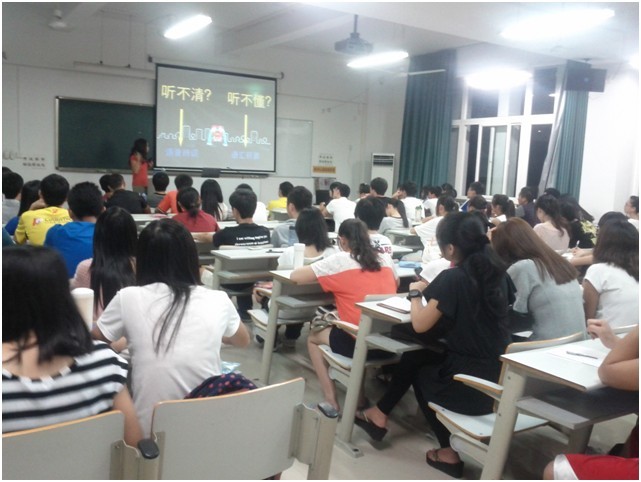 返回
教育头条
返回
教育头条

2018年12月英语四级新闻听力练习题 备考四级
1.
A. To measure the performance of the driver assistance systems in real-world test situation.
B. To test whether driver assistance systems can the stop the car automatically in case of an emergency.
C. To test newly designed vehicles equipped with driver assistance technology.
D. To improve the success rate of driver assistance systems in real-world test situation.
2.
A. Incorrect braking.
B. Following cars in front of them too closely.
C. Making unexpected speed changes.
D. Sudden breaking down.
1. According to the news report, what’s the aim of the study
A. To measure the performance of the driver assistance systems in real-world test situation.
B. To test whether driver assistance systems can the stop the car automatically in case of an emergency.1.
A. To measure the performance of the driver assistance systems in real-world test situation.
B. To test whether driver assistance systems can the stop the car automatically in case of an emergency.
C. To test newly designed vehicles equipped with driver assistance technology.
D. To improve the success rate of driver assistance systems in real-world test situation.
2.
A. Incorrect braking.
B. Following cars in front of them too closely.
C. Making unexpected speed changes.
D. Sudden breaking down.
A new study has found that driver assistance(辅助) systems fail to perform some actions in real-world test situations. The American Automobile Association of America tested four vehicles(机动车) equipped with driver assistance technology. Such technology is designed to electronically help drivers with things like staying in their lane. The systems can also stop the car automatically(自动地) in case of an emergency(紧急情况). The experiments aimed to recreate common driving situations to measure the performance of the assistance systems. All of the test models had systems designed to provide emergency stopping assistance. In addition, they were built to help keep vehicles within a lane and to back up speed control systems. The researchers reported repeated cases in which the test vehicle did not stay fully in its lane or moved back and forth within the lane. Other problems included the vehicles braking(刹车) incorrectly, following cars in front of them too closely and making unexpected speed changes. The study found that 90 percent of cases that required a driver to take over to avoid a crash happened because of a vehicle's inability to keep inside a lane. The AAA findings are the second tests to show that driver assist systems cannot deal with every situation in real-world driving, including some that are quite common. The Insurance Institute for Highway Safety released similar test results in August.

A. To measure the performance of the driver assistance systems in real-world test situation.
B. To test whether driver assistance systems can the stop the car automatically in case of an emergency.
C. To test newly designed vehicles equipped with driver assistance technology.
D. To improve the success rate of driver assistance systems in real-world test situation.
2.
A. Incorrect braking.
B. Following cars in front of them too closely.
C. Making unexpected speed changes.
D. Sudden breaking down.
1. According to the news report, what’s the aim of the study
A. To measure the performance of the driver assistance systems in real-world test situation.
B. To test whether driver assistance systems can the stop the car automatically in case of an emergency.1.
A. To measure the performance of the driver assistance systems in real-world test situation.
B. To test whether driver assistance systems can the stop the car automatically in case of an emergency.
C. To test newly designed vehicles equipped with driver assistance technology.
D. To improve the success rate of driver assistance systems in real-world test situation.
2.
A. Incorrect braking.
B. Following cars in front of them too closely.
C. Making unexpected speed changes.
D. Sudden breaking down.
A new study has found that driver assistance(辅助) systems fail to perform some actions in real-world test situations. The American Automobile Association of America tested four vehicles(机动车) equipped with driver assistance technology. Such technology is designed to electronically help drivers with things like staying in their lane. The systems can also stop the car automatically(自动地) in case of an emergency(紧急情况). The experiments aimed to recreate common driving situations to measure the performance of the assistance systems. All of the test models had systems designed to provide emergency stopping assistance. In addition, they were built to help keep vehicles within a lane and to back up speed control systems. The researchers reported repeated cases in which the test vehicle did not stay fully in its lane or moved back and forth within the lane. Other problems included the vehicles braking(刹车) incorrectly, following cars in front of them too closely and making unexpected speed changes. The study found that 90 percent of cases that required a driver to take over to avoid a crash happened because of a vehicle's inability to keep inside a lane. The AAA findings are the second tests to show that driver assist systems cannot deal with every situation in real-world driving, including some that are quite common. The Insurance Institute for Highway Safety released similar test results in August.

感谢您阅读2018年12月英语四级新闻听力练习题 备考四级,我是教育宝专业的四级六级考试学习顾问王敏,从事教育培训行业以来,发现用户很难找到适合自己的课程,希望通过我的专业可以帮您制定出合适的学习方案。
教育宝四级六级考试频道为你提供8007家机构3272条真实评价,在这里您可以了解及时、全面的课程信息及真实用户评价,各位可以根据自己的实际情况选取适合的机构,选择四级六级考试并不是越贵越好,只有最适合的才是最好的。
在选课过程中如需帮助,您可以加我微信:18560125702,我将为您提供全面专业的选课帮助,让我们一起开始美好的学习之旅吧。返回教育宝头条

【免责声明】本文仅代表作者本人观点,与教育宝无关。教育宝对文中陈述、观点判断保持中立,不对所包含内容的准确性、可靠性或完整性提供任何保证。请读者仅作参考,特此声明!





